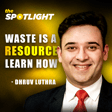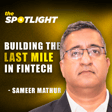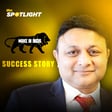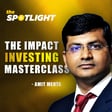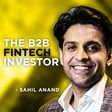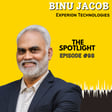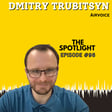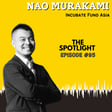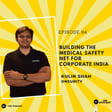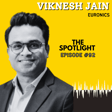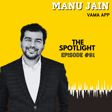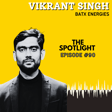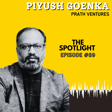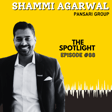Become a Creator today!Start creating today - Share your story with the world!
Start for free
00:00:00
00:00:01

The creator monetization playbook | Shlok Srivastava @ Layers
Shlok is a creator and social influencer who’s now creating a D2C brand in the mobile accessory space. He shares his journey of becoming a creator straight out of college instead of taking up a job, and how the creator economy works.
Transcript
Introduction to Neil Vodia and HyperX Media
00:00:00
Speaker
There are also many tech burners here, many for Neil Vodia, who is also the co-founder of HyperX Media, which is a milky start-up, product-based business content creation space. And there are many challenges and challenges to figure out.
Creators as Founders: Shlok Srivastava's Journey
00:00:32
Speaker
There are some obvious stereotypes about successful founders. They are either tech geeks from their tier one engineering colleges, or they are ex-consulting folks from tier one B schools. But breaking that mold is a new type of founder, who is a creator and a social influencer first. And one such founder is Shlok Srivastava, who runs the very popular YouTube channel Tech Burner, and is also the co-founder of Layers, which is a D2C brand in the mobile accessory space.
00:01:02
Speaker
In this candid conversation with your host Akshay Dutt, Shlok talks about his journey of becoming a creator straight out of college instead of taking up a job and how the creator economy works. Stay tuned and subscribe to the Founder Thesis Podcast on any audio streaming platform to learn from founders following unconventional paths to success.
00:01:30
Speaker
I thought I was an introvert, but I just did not know how to speak. So when I learned how to speak, I realized I am not maybe an introvert. I just started looking at life through a different lens to some extent. I started questioning that after acting, I did well.
00:01:56
Speaker
Then I realized maybe I am not an introvert. Maybe I just don't know how to speak or just as many changes I see, it became a lot more easier than I started to question everything. Maybe I can do this, maybe I can do that.
00:02:16
Speaker
I had certain boxes that I was putting myself in. I broke all the boxes. I broke all of them. And step by step by step, we are here. We have a team of 70. Tell me the journey. The journey is interesting. So your first experience like Kunlaga types was when you did like a drama performance. So how did that lead to you starting a channel?
Evolving as a Creator: Skills and Psychology
00:02:39
Speaker
So I was very much into mobile or it's kind of a routine.
00:02:45
Speaker
So I started making very very bad videos. So it was really bad but it was helpful maybe to just think well together.
00:03:02
Speaker
And these videos were about how to root your Android phone, how to root, how to do, install ROM, custom ROM, very niche, very technical. So it became more like cycle of fulfillment.
00:03:18
Speaker
So it went from 50 to 60 to 70, 80, 90, 100. It kept on increasing. So it was more like a gradual process to 60 to 70, 80, 90, 100. And it took me, I think, two to three years to actually learn how to speak properly in front of camera. It was a very low process. And all throughout college I kept making it. But after college, I had a choice. By the time you went in,
00:03:48
Speaker
4th year, I have a subscriber count. 10,000, 20,000 something, if I remember correctly. I don't know the exact number, but this is for that niche kind of content. Yeah. Did you also learn Kasa content? This was for very niche type of content. What technical, overly technical content.
00:04:05
Speaker
And I had a choice. I take up a job. I run this channel and try to be independent and run the business or something. So at that time, it was a very hard choice. You know, you do a job, but I was like, no, there is no plan B. So I took.
00:04:24
Speaker
It made sense. It makes sense now, but didn't make sense then. It took a lot of time. But I think once you make a decision, I think you put everything into it, it just works. So that's what I did. Initially, I was making videos in England. And because I was around people joining me. Everybody speaks more or less English.
00:04:53
Speaker
And I think creating content is less about understanding the content and it is more about understanding how the human brain works and how human psychology works.
00:05:18
Speaker
But I think it was deeper. When you're creating something new, if you look at the information that is around you and you create something, you cannot create something new by looking at everything that is around you or that is already happening and taking all that information and trying to create something out of it.
00:05:41
Speaker
I don't think you can create something new all that way. It's very difficult. A better way is to understand how a person connects with the product directly and try to re-engineer that in a way that is better. So that was the approach I took. I understood how a person is using his mobile.
00:06:03
Speaker
It is a very emotional connection with the smartphone. It is a very emotional connection with the smartphone. There is a lot more emotion through this mobile than tech people realized.
00:06:33
Speaker
I think vote for different. From what early was there?
00:07:07
Speaker
Like specifications, features...
00:07:18
Speaker
If you look at the website, you can see that there is no camera, you can see the camera, you can see the photo of the camera, you can see the camera.
00:07:40
Speaker
We realized that the technology holds a very strong emotional world. We tried to portray that through our readings.
00:07:52
Speaker
So that is one reason I believe why we are so big today. And I think that is something that differentiates us. I think we have, I had to re-engineer how I am using my mobile and then try to do that for our videos.
Team Building and Diversity in Content Creation
00:08:15
Speaker
I was sharing emotional experiences and not specifications. When I was telling people how actually a phone is. So I tried to do that or I tried to figure out your experiences. But essentially what they're trying to do is make your life easier.
00:08:38
Speaker
I tried to understand how this piece of mobile is trying to make someone's life easier. That's how we grew. And that's, I think, understanding people is the biggest part of any business. Not understanding the product, but understanding how people will use that product. I think that's the biggest. What I have felt is the biggest. Do you do anything specific to make sure that you have your pulse on the consumer's hand so that you don't lose your empathy?
00:09:06
Speaker
Because your biggest insight was that you need to have that empathy for your viewer. And you are able to make videos that relate, that they relate to and videos that go viral. Do you do something so that the empathy remains? Currently, I'm not the only one doing it.
00:09:25
Speaker
We try to understand the audience. I'm sure your team, you would have selected your team to be representative of your audience. If your audience is a young people of a certain age group, in a way your team itself is your primary consumer research panel. Essentially, the target audience becomes everybody. It is not just like tech one alone.
00:09:55
Speaker
We would want that to be our team. But perfect teacher is someone. Just go knowledge.
00:10:02
Speaker
I think we want technology to be fun and accessible and simple. But if we select a team based on the target audience, it would not be a nice thing to do. I think Uber may develop a regular consumer.
00:10:25
Speaker
I think our team has to be very competent when it comes to technology. And also, they would have to... But when they talk to the audience, when they write a verdict, they should be able to compile all that information into a few simple words. So I think that is what a good teacher also is. They try to make it very simple.
00:10:50
Speaker
How did you, when you passed out, you were a solo YouTuber. How did that become a team? What was the way in which you thought, I don't just want to be on YouTube. Tell me that journey. I was making, I think, 20,000, 30,000 a month or something. Which was the ad shares, like the revenue shares of YouTube.
00:11:16
Speaker
That was 30,000 was on YouTube. So I realized if we want to scale, I would need someone who can edit videos. So first step was that I just hired an editor. I was paying him more than I was making. So like 30,000, I was earning 30,000. I would pay him 20,000. So I would be left with 10,000.
00:11:39
Speaker
That was a weird thing. But I think that was a very good decision. But eventually things made sense. And step by step I have been just hired and hired as soon. I felt that someone else can do.
00:11:58
Speaker
Just to maybe free up my time and for me to be able to do new things, I hired. There can be the sequence in which you hired. Like first you had an editor then. So first I hired an editor. Second, I hired a person who managed communications and also a little bit of ideation. So in the starting, everybody used to do everything. Then I hired a
Diversifying Content and New Ventures
00:12:19
Speaker
person for communications and was another editor who could also shoot. So it was like four of us and we all were able to do everything, but had a skill set.
00:12:28
Speaker
And from then on, we just hired a lot of people. We hired people in content and editing and shooting and HR. And then as we started different projects, we hired different people. So what were the projects you started to diversify away from only YouTube? We understood first of all, for the majority part of YouTube.
00:12:47
Speaker
Hamara type is way better than we focused 100% on one single thing. It would be among the best text base.
00:13:04
Speaker
If you look at Instagram, you can see the content of it. So you can expand it. If you look at YouTube, you can see that at least we know the number one spot reach. And I could automate the growth.
00:13:19
Speaker
to some extent, and then Instagram, Twitter, all the platforms that we built. And from there, we created teams for product businesses. Me and Neil started a product brand. We realized we have a product. We started a product brand. We started a few other things. We started creating other channels.
00:13:45
Speaker
and we started creating content for, let's say, other people also, other businesses also. So currently, if I'm being very honest, we have built out a very good foundation and we spent the last, I would say, 3-4 years building the foundation for product businesses, for content businesses, for scaling content.
00:14:08
Speaker
not just in the tech space outside of the tech space and for creating even digital products and physical products almost all occurred. We set the foundation right and I believe next five years, everything that we are doing will be disrupted. We will be disrupting every space that we enter.
00:14:26
Speaker
Today, where do you stand? What is your total across all channels, followership? What kind of revenue do you expect to close this year at? I think you'd be ending anywhere between 20 to 40 crore or something like that. But the cashier might be accurate soon, if other entrepreneurs are listening to me. The profitability in a business like this is roughly between 75 to 80%.
00:14:48
Speaker
Yeah, almost all of it is property. Everything is profit. I think it would be 90% because we barely make not exactly 90% but like if we want to maximize profit, we could go to 90%. Yeah, it's only salaries. There is the cost of product assets. Yeah, there's cost of production and all of that, but we own everything. We own our own production. We own our own content. We own the base. We own the equipment, all of it. We have reduced the cost a lot. But yeah, I think the profits would go into expansion.
00:15:18
Speaker
And your social followership is something I can say about like, I think 10 million is on YouTube, more than 2 million on Instagram. Yeah, I think it would be around, I think, 15 million or something, all around social media. So we have three channels on YouTube, one with around 10 million, one with 3 million, one with 5 lakh, and we have Instagram.
00:15:38
Speaker
two million something. We have Facebook at one million something. If only take one, I would say around 15 million something. And if we combine all the other channels, I think that we have, I think it would be 17, maybe more 17, 18.
00:15:53
Speaker
What is your revenue split? Like one part of revenue of course is like YouTube ad shell, but you would also be now directly working with brands and probably you would be earning from the, as a content agency, you're making content for others. So you would be getting something from that also. So what's the split? We are reinvesting a lot.
00:16:11
Speaker
The profits are reinvested. Whatever we need, we reinvested into the brand. And we reinvested that into other projects. So we're currently scaling all that up. The majority, I would say, it's a revenue stake bonus out there.
00:16:30
Speaker
I think it would be around 60-40, something like that. 40% is YouTube adsense and 60% is live stream collaborations or marketing. I would say that 60-40 is around. If I am correctly assuming that. But I don't think it would be like that.
00:16:57
Speaker
Is there some like some person or company that you want to be like that after five years you want to hit where they are something like that like
00:17:06
Speaker
where they are, or he is, or she is, or whatever it is. There's a lot of things I would love to take from Sari companies. Just say, I really like Bhagavan, how he has done influencer marketing. I think he is the best example of influencer marketing we have ever seen.
00:17:22
Speaker
There is like the way he comes on TV and gives out his products and as a business, what he has done is extraordinary. How he has used his leverage to sell products and create a brand is I would say I have not seen a better example.
00:17:38
Speaker
He's definitely one person that I would love to take things from. But of course, there's a lot of other brands. I really love how Marvel has done content. They have been able to create characters and they have been able to kill characters on demand. So, Marvel was created by Iron Man. Like essentially Marvel, the whole universe started with Iron Man.
00:18:01
Speaker
But now there is no Iron Man. Iron Man is dead. But the whole ecosystem is way bigger and they have been creating characters and creating movies on demand and how they have created this whole mighty world is very extraordinary. So a lot of companies that I take inspiration from would be Disney, Marvel, a lot of social media influencers who have built their own brands and built it into the content industry. A lot of people don't know 500 Crust.
00:18:28
Speaker
The founders in India, they have a lot of channels. I think they have distribution of over, I would say it's in the hundreds of millions of subscribers. So that guy I really like. I like Logan Paul, KSI, how they do marketing. In India, Bhuvanbam has done a lot of amazing things when it comes to the production space and scaling of content. But yeah, I try to take inspiration from everybody, but if I try to be like somebody, I would end up failing.
00:18:56
Speaker
because this is a new business, if I try to replicate someone, it is bound to fail. So yeah, and we would stay next steps behind. And we realized how hard it is, how hard it is to create a product, how hard it is to actually run a business. And we would be able to do it in six months, took us
00:19:18
Speaker
three years to do the same thing. And what is that thing?
Launching Layers: Challenges and Inspirations
00:19:22
Speaker
What did you like? What was the product you wanted to do which took three years? We created this company called Layers. We are essentially manufacturing these skins for all smartphones and laptops. First number, Layers for Shop, Logic Zone, next launch. But yeah, we thought it would be simple, but it was not. It took a lot of time. We had to like to set up a factory, to set up operations, to set up marketing, to set up
00:19:46
Speaker
all the people who design and from the performance marketing because we are doing end-to-end everything. We have our own factory, we have our own machines. Even importing the machines was a pain. I would say it was to some extent painful, emotionally painful. But at the end of the day, we were clear while we were doing it. So we just had to do it. And when we launched, we became the number one skin brand in India on the first day.
00:20:11
Speaker
Why didn't you just do collaborations? For example, like a lot of YouTubers do, you could collaborate with noise for co-branded smartwatch or you could collaborate with board for a co-branded speaker. Like why go through the effort of actually building a factory, building the product in-house and putting in all of that investment of money, of bandwidth, your personal bandwidth and so on. Because we are not in this too
00:20:37
Speaker
take part. We have not started this brand to just make a few bucks. We are here to take over and we are here to dominate. And the only way to dominate is when we own what we are doing. And that's what I truly believe. And the problem was we could have collaborated and we might do that in the future, but
00:20:57
Speaker
For us to be able to do that on scale for a hundred products, I think we had to understand how the product works, how the product business works, how the manufacturing works, how the operations work, how the marketing works, how everything works.
00:21:13
Speaker
only then it makes sense to collaborate because I think once you've tasted how everything is, then it's way easier to collaborate. And now if we can, if we have the leverage now, we have sold products, we have done things that have made sense.
00:21:29
Speaker
And also the product that we were building, nobody's doing that in India. And to collaborate, we would collaborate and create a rebranded version of an old product. We won't be able to create something new. I don't know the last time two brands collaborated and they created something that was completely new. It was usually just a rebrand. To create a product that is completely new, it requires a lot of hardware or it requires a lot of research and we were ready to put that hard work in.
00:21:57
Speaker
If we are able to crack that, we wanted the scar tissue. We wanted to know how to create a product and I think we can kill social commerce if we combine content and product and we know both of them very deeply. So we have become hard to kill.
00:22:20
Speaker
Okay, so tell me about what is the skin for a phone and how is it different from what is currently there like the covers and the cases. Essentially, this is like a material which you can stick on the back of your phone and it has a lot of textures, it has a lot of design and it does not make your phone bulky.
00:22:42
Speaker
I have a very creative journey. I think many of the recent decisions were not made out of sense. I think India is very caught up when it comes to IT jobs. We wanted to inspire some sort of creativity in people. It's not just true words. Our creative person is not expressed in any way. It's a dance, dance, dance.
00:23:04
Speaker
So we wanted people to be inspired, to be creative and create things just for the sake of creation. Globus create karban, they don't have to worry about survival. So that's what the whole goal was. This essentially is just like a symbol. It is just something that motivates you towards our journey and it looks really nice and it is the best skins in the world because we have textures and our own designs and all of that. It's very hard for a new brand to compete with. It's a new category.
00:23:34
Speaker
It's a new category and for a new brand to compete with us, we have to, we have a leverage. We have distribution of over 40, 50 million people a month who we can show the skin to. And if a new brand has to buy that, they would have to pay crores and crores in rupees. And so we have the distribution plus our product is better than what is currently there in the market. So a new brand who has to start will have to invest in factories and try to figure out all the research and how we created this product.
00:24:02
Speaker
Is it easy for a customer to apply this on their own? Is it a DI1? Yeah, you can apply it on your own. If you mess it up, you can just remove it and apply it again. So, that is not that much of a problem. But this will protect from scratches only, right? It will not protect from the phone falling. It does protect your phone from scratches. But essentially, a phone has to be damaged. And we felt that
00:24:32
Speaker
If you have ever noticed how people buy clothes, 70% of it is just my body. And 30% is like, it's functional.
00:24:47
Speaker
I think that is the same for our product is it's an accessory. It is a fashion product. It is an emotional product. It is something that connects with people and it does solve a purpose, but like we have it more to inspire people rather than for it to become like a feature set.
00:25:05
Speaker
Do you see a similar journey on the product side, like tech button? So like tech button where you started with very niche videos. And to me, this also seems like a niche product, not exactly a mass market product. So are you looking at like launching more stuff, which is old mass market also? 100%.
00:25:22
Speaker
It's a step-by-step journey. I think first we have to own a niche, then we can move to the next one. So if we can own a niche and create a brand, then we would go into places where there is no brand. Currently, we see 2-3 spaces, Scream God has a brand name.
00:25:39
Speaker
or you go to brand for screen guards and we see there is no go to brand for let's say cases also. That also I have had conversations with a lot of companies who have started cases on the market because no one can
00:25:54
Speaker
We can do that marketing for free. So we have a huge leverage. I think that would be our next steps and KSSK market is definitely very big. Step by step, maybe these are the two things that we see. But step by step, we would increase. So we would have to go there and then look forward.
00:26:15
Speaker
I think this would teach you D2C, like how to run an e-commerce website, how to handle logistics and customer service and all of those different elements. But this would be D2C without that kind of customer acquisition cashword because you are like, because of your status as an influencer, you already have access to those eyeballs, so you don't need to do that kind of cashword. Yeah, we would have to do the cash again also.
00:26:45
Speaker
Ashburn as well as leverage from the influencers. We are promoting them on my channel and at the same time we are also doing influencer marketing and performance marketing and all of that. So we are doing that parallelly. We are using all the leverage we can. So it's not like we won't be reinvesting the profits and all of that. You do everything and that is the only way.
00:27:06
Speaker
a business can work currently. You have to use all the leverage that you have and our leverage is content. We know how to create content. We know how to market and understand the market. So we would use all of it. We would use all of it. So yes, we are starting but we know the basics of the D2C market. We know the we know content quite well and
00:27:27
Speaker
We are trying to scale both of them at the same time. It is a long-term process, but people will see how it is working two to three years from now. And when they realize that this strategy is very powerful, then they will adopt it. And I believe we would be three or four steps ahead by then. Amazing. Love your usage of the word scar tissue. It's a great way for a founder to think that I want that scar tissue. Yeah.
00:27:53
Speaker
What is the market for skins? What is the total addressable market or what kind of will layers be doing like a couple of hundred covers in turnovers in a couple of years? It's hard to predict because if you see, because we are the ones creating the market and we are the ones because it's a new product. It's a new product. Most of the people don't even know what skins are. So we are essentially creating a new category and we are promoting it to 45 million people a month and trying to create that
00:28:23
Speaker
But I think with the new products you plan to launch, like with cases and covers and... 100% we can do. 100% we can do. Because cases are very, very big market. Screen guards, cases, everybody buys screen guards, everybody buys cases. So that is definitely a very big market. And big market for us, because we already are established tech brand. We already have the distribution. So you would be able to make profits where nobody else can make profits.
00:28:49
Speaker
So that is where we have a big leverage. So yeah, that's that. But yeah, it would be tough. It would be tough. And you want to make everything in-house. Like when you start doing cases, streamlines, you want to make it all in-house. So this is only for cases that you're doing it in-house and you will explore.
Product Distribution and Brand Strategy
00:29:07
Speaker
Maybe not at all. We will see what the best calculations are, what logically makes sense for the business and what logically makes sense for the consumers. If it is better for us, if the profit margins are better, if we create the product ourselves, and if the quality is better, if we created ourselves, then we might do it ourselves, but we are okay outsourcing the product manufacturing.
00:29:31
Speaker
because we would keep the research and development with us 100%, but we would be okay working with other factories. So that won't be a challenge for us.
00:29:41
Speaker
And like Amazon Flipkart, like these marketplaces would be also major distribution channels, right? Like right now you're starting with your own D2C website, but I'm sure you would want to be present across the ecosystem. That would also be more like a... I think it all depends on what logically makes sense. If the consumers find it better to buy it from other websites, that would be okay with that.
00:30:07
Speaker
but also the profits and how everything works, but we would want it to be our website only, but we understand how the market works and how everything is. I think we would have to sell on Amazon and Flipkart and all these other vendors, but we want leverage. So if we are able to create a brand and Amazon comes to us, so that would be a bigger leverage that would give us edge to negotiate and all of that. So wherever we get better leverage, we would want that. Yeah.
00:30:36
Speaker
Currently, I can't make very solid claims when we are not even ready with the final product. So Neel, let's come to you now. So what is your go-to-market strategy for Layers? What is the way in which you launched the brand? How did you get traction for it? And how are you converting your eyeballs into transactions? So essentially, what we felt is that we were the content creator of the product brand.
00:31:03
Speaker
has not been successful. We knew that. Give me some examples. What have people tried without naming names, but what are the products that people have tried?
00:31:19
Speaker
People have tried creating merchandise, tried creating t-shirts and ODS and some have tried creating bags and necklaces and some have tried to do gift drops and all of that. But none of it has worked. No one has actually created a brand.
00:31:37
Speaker
We realized that it was tough for the Indian market to be difficult. The Indian market is a product based on what is difficult. And I think the same space is difficult. But what we did different was, we realized that we were never able to influence the market. What they tried to do was, they just tried to sell the product. So I think the influencer
00:32:05
Speaker
His strength is not serious. What he knows is, what he knows is, of course, what he knows is, of course, what he knows is, of course, what he knows is, of course, of course, of course, of course, of course, of course, of course, of course, of course, of course, of course, of course, of course, of course, of course, of course, of course, of course, of course, of course, of course, of course, of course, of course, of course, of course, of course, of course, of course, of course, of course, of course, of course, of course, of course, of course, of course, of course, of course, of course, of course, of course, of course, of course, of course, of course, of course, of course, of course, of course, of course, of course, of course, of course, of course, of course, of course, of course, of course, of course, of course, of
00:32:34
Speaker
If you like this video, please subscribe.
00:32:37
Speaker
It's like a triangle. The audience, the audience, the emotional connection, the brand, the vision. And we just kept tuning that vision. Not the product, but the brand, the vision, and the creative. And you can explore and express it. There are stories and videos that align with the design. But if you want to become a designer, please become a creator.
00:33:06
Speaker
It is a very relatable vision. It is a brand-building brand. And because vision is powerful, it is not related. If vision is an influencer, it still holds a lot more value. If vision is powerful, it is not connected. If vision is connected, it is not connected. I think that is something that Juhamne
00:33:31
Speaker
So this is a very simple vision connection. But actually, it was exude through content. It was like a very interesting strategy. But at the same time, it was a line. But at the same time, it was a view. So it was a challenge that we had to continue. And we had to bring in vision and define it.
00:34:00
Speaker
product list, integrations, or dedicated videos, but essentially it was
00:34:09
Speaker
What is the triangle between a product or a brand? It is a vision of a brand. Usually, influencers are like straight lines. influencer, beachwear product, then audience. So, audience is like disconnected with the influencer or the product. Influencer is a visual disconnector. So, I think that is what we did differently. So, I think that is what we did differently. So, I think that is what we did differently.
00:34:33
Speaker
So, that is what we did differently and that is why our product-based business worked in comparison to what Baki Joe creators around said. What do you sell monthly? Like how many pieces a month? I don't know the last sales data. I am very much...
00:34:54
Speaker
This is without the paid push which we have planned for the month of November. This was purely organic based on the content we have generated so far. Next month will be interesting until now since we will be pushing it via other videos that influence our performance as well. Like you said, the challenge of creating a video which is viral and also is promoting the product. Give me some examples of how you did that. For example, I will give you an example. We have a product promote.
00:35:24
Speaker
So, rather than promoting the product, we just shared the vision.
00:35:35
Speaker
Let's say you can get 50% off, do this in the comment section. We didn't do that. What we did is we created a documentary. We created pieces like we have bought a 30 lakh rupees machine. It's like a very viral type of content.
00:35:56
Speaker
So, we try to do a documentary process. So that's what we did. I think there's no formula for it. It is all very in context to who the influencer is. But essentially what works is a good story that aligns with the vision and
00:36:26
Speaker
Around content, there is a viral content. It is very value centered content. It is very audience centered content. It is very serious content.
00:36:46
Speaker
Nobody talks about the vision. That's what I feel. So do you live your life in front of the camera? Like are you constantly capturing what's happening in your life? For example, I would feel
00:37:07
Speaker
I want it to be a blog question. We want to do things which will disrupt whatever industry we go in and that would also be tested. That's the whole plan.
00:37:22
Speaker
But yeah, we are documenting everything, not just because we want to create a good documentary, but because it inspires people. It inspires people to do something that they want to create a good documentary. And they want to do something that they want to do. They want to call it, they want to do something that they want to do. And they know that they want to create something that they want to do.
00:37:49
Speaker
The failure of a deal is not a failure. It is a failure. That is why I think it is a failure.
00:37:58
Speaker
So, the fact that you were talking about teens, that actually gave you good content, right? Because every time something went wrong, that was content. Yes. Every time something went wrong, it's like a good story. Yeah, amazing. Do you plan your videos in advance or do you just keep recording it and the idea strikes you? What's your process of making videos?
00:38:25
Speaker
Yeah, it goes something like that. We just keep recording everything and we try to make something out of it. It was a documentary process, but when it comes to actually promotional content, it's different. We would have ideas like, how to create an iPhone, and then we would
00:38:55
Speaker
It's like good content. We create content. This type of idea is for promotional content. But the documentary part, of course, you can't
00:39:13
Speaker
like scripted. It has to happen organically. That is very organically. And what about the regular tech bonus content, which is like the reviews and all those like planned in advance and all that. How does that content get created? Like what's the process? The processes we start scripting, we start testing and all that. And whenever it jump data, but like we try to plan it in advance,
00:39:35
Speaker
We have to test it. It's like a mix between pre-planning.
00:39:51
Speaker
But it does not decide what kind of videos you want to do. Do you look at, say, Google Trends, what are people searching for and use that data to decide? Is it more based on your gut feel and empathy? It does. Again, it comes down to a person and usually a person is very, very simple.
00:40:18
Speaker
If you look at content and if you look at what works in India, it is very simple. If you open up television
00:40:41
Speaker
It is very socially driven. Even if you look at YouTube all the time.
00:40:48
Speaker
Young audience. What works with young audience is social dynamic. With school, college and romance. These are the top trending topics.
00:41:06
Speaker
We have to understand the social dynamics in the use of technology. And we create technology. So it is just about understanding audience. It is very scientific, but at the same time it is instinctive. But that is how we usually do it.
00:41:34
Speaker
So tell me something about YouTube shorts that promote and Instagram has reels and do these formats also have Asworth's earning opportunities that direct the whole thing because like in YouTube.
Advice for Aspiring Founders
00:41:48
Speaker
I was very excited about this cookie and all I'm saying is
00:41:53
Speaker
We are lucky. We are lucky. We are able to sell here at very
00:42:20
Speaker
So, I am usually in favor of thoughts and all of that. So, to sell, to have an audience for everything. So, I think it is very powerful. I think it is very powerful. So, I think it is very powerful. So, I think it is very powerful. So, I think it is very powerful. So, I think it is very powerful. So, I think it is very powerful. So, I think it is very powerful. So, I think it is very powerful. So, I think it is very powerful.
00:42:43
Speaker
So, I've seen the same way for short form one day. Of course, one day long form videos rain. But short form logo, they value their time to short form the right. Short form right now is like a way to build your audience. It's not a way to monetize, right? But short form, you will get more views, some of those will subscribe and I don't think it will be short form content where it's not monetization.
00:43:06
Speaker
There is a lot of brand new content in the platform where there is people there, there is distribution, there is money. Where there is people...
00:43:18
Speaker
I don't see... It's like we're just early... I thought like... Like early days of YouTube, basically. Okay, got it. What's your advice to people who want to be founders and who want to win their own startups? I would say it's like...
00:43:43
Speaker
starting a company is like chewing glass and staring into the abyss. I am not a motivational speaker and I genuinely believe that if you're starting a company, you should know the truth and the truth is almost 95% of companies that have started fail and it is hard but it is the most fulfilling thing you can do. It will change you as a person, not the successes but also the failures
00:44:12
Speaker
And if you're starting, if you're doing it for something that impacts not just you, but if you're doing it for the people, it might work. But it's like going into the jungle and trying to figure out the way and you don't have anything. So it's definitely tough. It's definitely scary. A lot of emotional moments and a lot of founders won't talk about it. A lot of
00:44:38
Speaker
founders, they go into depression, a lot of founders become very lonely, they put all of their lives into something and it doesn't work. But if it works, it makes you so powerful and it's something that I think everybody should do. Everybody should go into the jungle, everybody should figure out things and if even a small majority of people can, then it would change the whole country.
Closing Remarks and Listener Engagement
00:45:02
Speaker
And that brings us to the end of this conversation. I want to ask you for a favor now. Did you like listening to this show? I'd love to hear your feedback about it. Do you have your own startup ideas? I'd love to hear them. Do you have questions for any of the guests that you heard about in this show? I'd love to get your questions and pass them on to the guests. Write to me at adatthepodium.in. That's adatthepodium.in.

